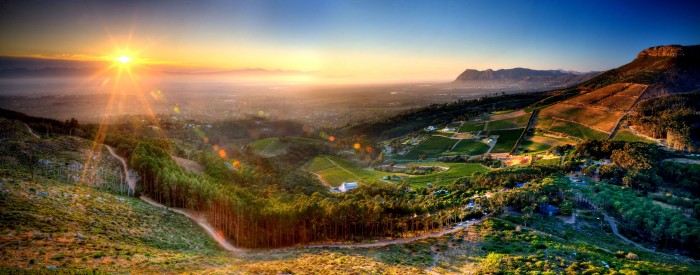The power of restraint
Author: Sophie Thorpe
Alexander Waibel appears restless in his enthusiasm as he speaks to a room full of Berry Bros. & Rudd staffers about Constantia Glen, and the exceedingly elegant wines they produce.
While their first vintage was only 2005, the property has been in the family since the 1950s. When Alexander’s grandfather purchased the farm around 60 years ago, the land was filled with cattle and apple and pear orchards. Apples and pears aren’t the quintessential South African crop, given it’s a country whose climate is not dissimilar to that of Australia. The Western Cape benefits from the cooling influence of the Atlantic (namely the Benguela Current flowing up from Antarctica), not to mention the infamous Cape Doctor – a persistent south-easterly wind that can be as much a hindrance as a help.
Constantia is the oldest, coolest and smallest wine-producing area in South Africa, with the region’s earliest estate dating back to 1685. Its cool temperatures have meant that most producers in the area plant between 70 and 85 percent white grapes, but Constantia Glen’s unique position, nestled between Table Mountain and Constantiaberg, benefits from late-afternoon sun, and thus can produce more red grapes. As such, their plantings are two-thirds red grapes and just a third white.
Alexander’s European upbringing is apparent in the style of wines produced, as well as his belief that wines are made in the vineyard not the cellar. He grew up drinking Bordeaux and wanted to create wines of similar stature in South Africa. Fortunately the classic Bordelais varietals (Cabernet Sauvignon, Merlot, Cabernet Franc and Petit Verdot for reds, Sémillon and Sauvignon Blanc for whites) thrive in his vineyards, struggling just enough at their southern limit to produce fruit of exceptional quality.
Their Sauvignon Blanc (which includes five to six percent Sémillon) is beautifully fresh but not overly green or pungent, the six months on the lees adding a weightiness. Alexander describes what he sees as a ‘flashback’ of acidity on the finish, reviving the palate and leaving you reaching for another glass. Constantia Glen Three is a round and plummy Merlot-dominant blend, while the Five is a more intense Petit Verdot and Cabernet Sauvignon-dominant encépagement.
Evident in all the Constantia Glen wines is an elegance and restraint not traditionally associated with South Africa, but which, for me, echo the equally sophisticated Mullineux & Leeu Family wines. As Catriona Felstead wrote last month, the new generation of winemakers in South Africa are producing sensational wines which are the ultimate expression of the country’s terroir.



